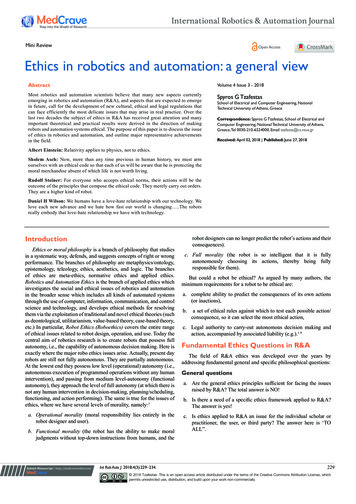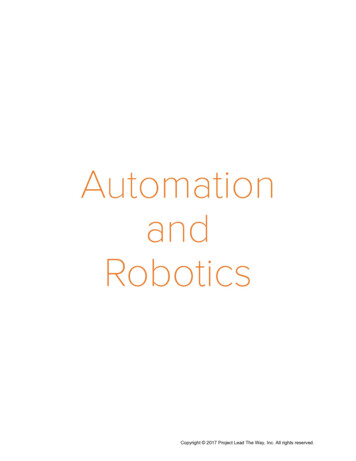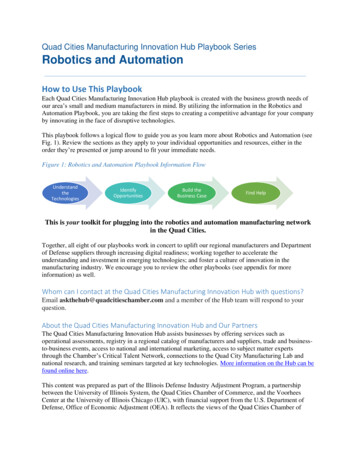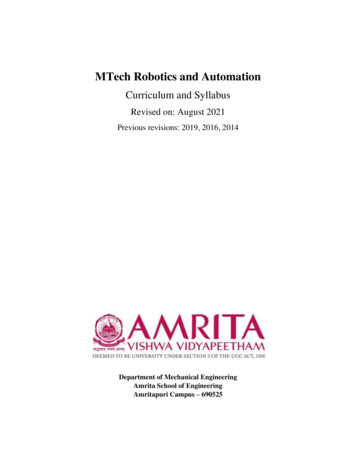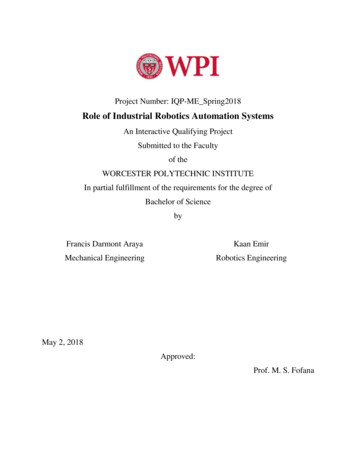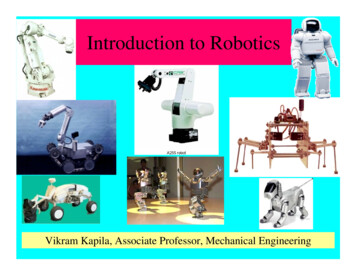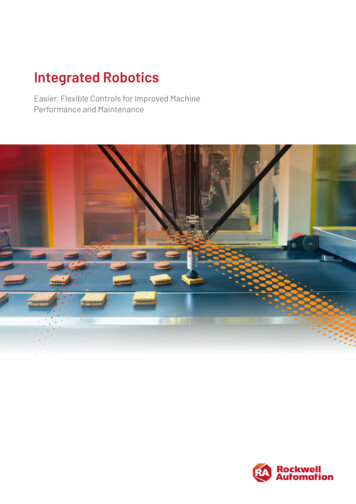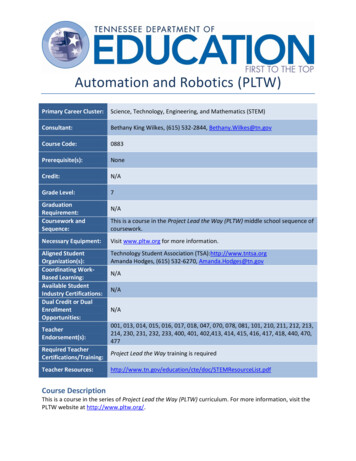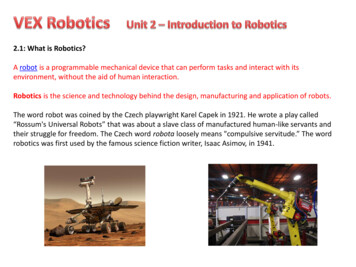
Transcription
2.1: What is Robotics?A robot is a programmable mechanical device that can perform tasks and interact with itsenvironment, without the aid of human interaction.Robotics is the science and technology behind the design, manufacturing and application of robots.The word robot was coined by the Czech playwright Karel Capek in 1921. He wrote a play called“Rossum's Universal Robots” that was about a slave class of manufactured human-like servants andtheir struggle for freedom. The Czech word robota loosely means "compulsive servitude.” The wordrobotics was first used by the famous science fiction writer, Isaac Asimov, in 1941.
2.1: What is Robotics?Basic Components of a RobotThe components of a robot are the body/frame, controlsystem, manipulators, and drivetrain.Body/frame: The body or frame can be of any shape andsize. Essentially, the body/frame provides the structure ofthe robot. Most people are comfortable with human-sizedand shaped robots that they have seen in movies, but themajority of actual robots look nothing like humans. Typically,robots are designed more for function than appearance.Control System: The control system of a robot is equivalentto the central nervous system of a human. It coordinatesand controls all aspects of the robot. Sensors providefeedback based on the robot’s surroundings, which is thensent to the Central Processing Unit (CPU). The CPU filters thisinformation through the robot’s programming and makesdecisions based on logic. The same can be done with avariety of inputs or human commands.
2.1: What is Robotics?Basic Components of a RobotManipulators: To fulfill their purposes, many robots are required to interact with their environment,and the world around them. Sometimes they are required to move or reorient objects from theirenvironments without direct contact by human operators. Unlike the Body/frame and the ControlSystem, manipulators are not integral to a robot, i.e. a robot can exist without a manipulator. Thiscurriculum focuses heavily on manipulators, especially in Unit 6.
2.1: What is Robotics?Basic Components of a RobotDrivetrain: Although some robots are able to perform their tasks from one location, it is often arequirement of robots that they are able to move from location to location. For this task, they requirea drivetrain. Drivetrains consist of a powered method of mobility. Humanoid style robots use legs,while most other robots will use some sort of wheeled solution.
2.1: What is Robotics?Uses and Examples of RobotsRobots have a variety of modern day uses. These usescan be broken down into three major categories:1. Industrial Robots2. Robots in Research3. Robots in EducationIndustrial RobotsIn industry, there are numerous jobs that require highdegrees of speed and precision. For many yearshumans were responsible for all these jobs. With theadvent of robotic technology, it became evident thatmany industrial processes could be sped up andperformed with a higher degree of precision by theuse of robots. Such jobs include packaging, assembly,painting, and palletizing. By the end of 2014, theInternational Federation of Robotics predicts thatthere will be over 1.3 million industrial robots inoperation worldwide!
2.1: What is Robotics?Uses and Examples of RobotsRobots in ResearchRobots come in very handy in the world of research, asthey often can be used to perform tasks or reachlocations that would be impossible for humans. Fordecades, NASA has utilized probes, landers, and roverswith robotic characteristics to study outer space andplanets in our solar system.
2.1: What is Robotics?Uses and Examples of RobotsPathfinder and SojournerThe Mars Pathfinder mission developed a uniquetechnology that allowed the delivery of aninstrumented lander and a robotic rover, Sojourner, tothe surface of Mars. It was the first robotic rovingvehicle to be sent to the planet Mars. Sojournerweighs 11.0 kg (24.3 lbs.) on Earth (about 9 lbs. onMars) and is about the size of a child's wagon. It has sixwheels and could move at speeds up to 0.6 meters (1.9feet) per minute. The mission landed on Mars on July4th, 1997. Pathfinder not only accomplished this goalbut also returned an unprecedented amount of dataand outlived its primary design life.
2.1: What is Robotics?Uses and Examples of RobotsSpace Shuttle Robotic ArmWhen NASA scientists first began the design for the spaceshuttle, they realized that there would have to be someway to get the enormous, but fortunately weightless,cargo and equipment into space safely and efficiently.The remote manipulator system (RMS), or Canadarm,made its first flight into space on November 13, 1981.The arm has six joints, designed to simulate the joints ofthe human arm. Two are in the shoulder, one is at theelbow, and three are in the highly dextrous wrist. At theend of the wrist is an end effector which can grab orgrapple the desired payload. In the weightlessenvironment of space, it can lift more than 586,000pounds and place it with incredible accuracy. Its totalweight on earth is 994 lbs.
2.1: What is Robotics?Uses and Examples of RobotsSpace Shuttle Robotic ArmThe RMS has been used to launch and rescue satellitesand has proven itself invaluable in helping astronautsrepair the Hubble Space Telescope. The Canadarm’s finalshuttle mission took place in July of 2011, marking the90th time it was used on a shuttle mission.
2.1: What is Robotics?Uses and Examples of RobotsMobile Servicing SystemA similar device to the RMS, the Mobile Servicing System (MSS) otherwise known as Canadarm2 wasdesigned to provide manipulation functions for the International Space Station. The MSS is responsiblefor servicing payloads and instruments attached to the International Space Station, while also assistingwith the transport of supplies and equipment around the station.
2.1: What is Robotics?Uses and Examples of RobotsDextreAs part of the Space Shuttle mission STS-123 in 2008,the shuttle Endeavour carried the final part of theSpecial Purpose Dexterous Manipulator, or "Dextre.“Dextre is a robot with two smaller arms. It is capable ofhandling the delicate assembly tasks currentlyperformed by astronauts during spacewalks. Dextre cantransport objects, use tools, and install and removeequipment on the space station. Dextre also isequipped with lights, video equipment, a tool platform,and four tool holders. Sensors enable the robot to"feel" the objects it is dealing with and automaticallyreact to movements or changes. Four mountedcameras enable the crew to observe what is going on.Dextre's design somewhat resembles a person. Therobot has an upper body that can turn at the waist andshoulders that support arms on either side.
2.1: What is Robotics?Uses and Examples of RobotsRobots in EducationThe field of robotics has become an exciting and accessible tool for teaching and supporting science,technology, engineering, mathematics (STEM), design principles, and problem solving. Roboticsenables students to use their hands and minds to create like an engineer, artist, and technician does,all at once. It allows for instantaneous application of scientific and mathematical principals.Why is Robotics Important?As we saw in the uses and examples of robotics section, robotics is an emerging field with applicationsin many facets of our lives. It is important for all members of society to have an understanding of thetechnology that surrounds us. However, robotics is important for more than that reason. Roboticsprovides a unique combination of the pillars of STEM: science, technology, engineering and math.When taught in schools, it allows students to experience a true interdisciplinary lesson while studyinga cutting edge and exciting topic. Also, the aesthetics which go into the design and creation of robotsallow students to experiment with an artistic side, while working through technical principals. Thiscombination rewards participants on a plethora of different learning levels.
2.2: VEX Robotics Design SystemThe VEX Robotics Design System, which was created by Innovation First, Inc. It has been designed tonurture creative advancement in robotics and knowledge of science, technology, engineering, andmath (STEM) education. The VEX system provides teachers and students with an affordable, robust,and state-of-the-art robotics system suitable for both classroom use and for use on the competitionplaying field. VEX’s innovative use of premade and easily formed structural metal, combined with apowerful and user-programmable microprocessor for control, leads to infinite design possibilities.Beyond science and engineering principles, a VEX Robotics project encourages teamwork, leadershipand problem solving among groups. It also allows educators to easily customize projects to meet thelevel of students’ abilities.For more information on the VEX Robotics Design System, please visit: http://www.vexrobotics.com/VEX Product Subsystems
2.2: VEX Robotics Design SystemStructure SubsystemThe parts in the VEX Structure Subsystem form the baseof every robot. These parts are the “skeleton” of the robotto which all other parts are attached. This subsystemconsists of all the main structural components in the VEXRobotics Design System, including all the metalcomponents and hardware pieces. The Structure andMotion subsystems are very tightly integrated to form thechassis of the robot.In the VEX Robotics Design System the majority of thecomponents in the Structure Subsystem are made frombent aluminum or steel sheet metal. These pieces come ina variety of shapes and sizes and are suited to differentapplications on a robot.The VEX structural pieces all contain square holes (0.182”sq) on a standardized 0.5” grid. This standardized holespacing allows for VEX parts to be connected in almostany configuration. The smaller diamond holes are there tohelp users cut pieces using tin snips or fine toothedhacksaws without leaving sharp corners.
2.2: VEX Robotics Design SystemStructure SubsystemVEX square holes are also used as an alignment featureon some components. These pieces will snap into placein these square holes. For example, when mounting aVEX Bearing Flat there are small tabs which will stickthrough the square hole and hold it perfectly inalignment. Note that hardware is still required to holdthe Bearing Flat onto a structural piece!
2.2: VEX Robotics Design SystemStructure SubsystemHardware is an important part of the StructureSubsystem. Metal components can be attachedtogether using the 8-32 bolts and nuts which arestandard in the VEX kit. These screws come in a varietyof lengths and can be used to attach multiplethicknesses of metal together, or to mount othercomponents onto the VEX structural pieces. Allenwrenches and other tools are used to tighten or loosenthe hardware. There are also smaller 6-32 bolts in theVEX Robotics Design System, which are used only forthe mounting of VEX Motors and Servos.
2.2: VEX Robotics Design SystemStructure SubsystemWhen using screws to attach things together, there arethree different nuts which can be used.Nylock nuts have a plastic insert which will prevent thescrew from loosening. These nuts are harder to install;an open-ended wrench is needed to tighten them.However, these nuts will not shake loose due tovibration or movement.KEPS nuts have a ring of teeth on one side of themwhich will grip the piece they are being installed on. Anopen-ended wrench is not needed to tighten them, butit is recommended. These nuts are installed with theteeth facing the structure. They can loosen up overtime if not properly tightened, but they work well inmost applications.Regular nuts that have no locking feature. These basichex nuts require a wrench to install and may loosen upover time, especially as a result of vibration ormovement. They are thin and can be used in certainapplications where a Nylock or KEPS nut would not fit.
2.2: VEX Robotics Design SystemStructure SubsystemAnother useful structural component are the 8-32threaded standoffs; these standoffs come in a varietyof lengths and add a great deal of versatility to the VEXkit. Standoffs are useful for mounting components aswell as for creating structural beams of great strength.One of the key features of many VEX structural parts istheir “bend-able” and “cut-able” nature. Users caneasily modify many of these structural parts into newconfigurations better suited for their current needs.These parts were designed to be modified!
2.2: VEX Robotics Design SystemMotion SubsystemThe Motion Subsystem comprises all the componentsin the VEX Robotics Design System which make a robotmove, the muscle of the robot. These components arecritical to every robot. The Motion Subsystem is tightlyintegrated with the components of the StructureSubsystem in almost all robot designs. In the VEXRobotics Design System the motion components are alleasily integrated together. This makes it simple tocreate very complex systems using the basic motionbuilding blocks.The most fundamental concept of the MotionSubsystem is the use of a square shaft. Most of the VEXmotion components use a square hold in their hubwhich fits tightly on the square VEX shafts. This squarehole / square shaft system transmits torque withoutusing cumbersome collars or clamps to grab a roundshaft.
2.2: VEX Robotics Design SystemMotion SubsystemThe square shaft has rounded corners which allow it tospin easily in a round hole. This allows the use of simplebearings made from Delrin. The Delrin bearing willprovide a low friction piece for the shafts to turn in.These VEX Delrin bearings come in two types, the mostcommon of which is a Bearing Flat. The Bearing Flatmounts directly onto a piece of VEX structure andsupports a shaft which runs perpendicular and directlythrough the structure. Another type of bearing is aBearing Block; these are similar to the “pillow-blocks”used in industry. The Bearing Block mounts on a pieceof structure and supports a shaft which is offset above,below, or to the side of the structure. Some bearingscan be mounted to VEX structural components withBearing Pop Rivets. These rivets are pressed into placefor quick mounting. These Rivets are removable; pullout the center piece by pulling up on the head of theRivet to get it to release.
2.2: VEX Robotics Design SystemMotion SubsystemThe key component of any motion system isan actuator, which is something which causes amechanical system to move. In the VEX Robotics DesignSystem there are several different actuator options. Themost common types are the VEX Continuous RotationMotors and VEX Servos. The Motors can rotateinfinitely, while the range of rotation of the Servos isrestricted to 150 degrees. Each VEX Motor & Servocomes with a square socket in its face, designed toconnect it to the VEX square shafts. By simply insertinga shaft into this socket it is easy to transfer torquedirectly from a motor into the rest of the MotionSubsystem.
2.2: VEX Robotics Design SystemMotion SubsystemThe Motion Subsystem also contains parts designed tokeep pieces positioned on a VEX shaft. These piecesinclude washers, spacers, and shaft collars. VEX ShaftCollars slide onto a shaft, and can be fastened in placeusing a setscrew.There are several ways to transfer motion in the VEXRobotics Design System. A number of MotionSubsystem accessory kits are available with a variety ofadvanced options, including spur gears, sprocket &chains, bevel gears, etc. For a full listing of what isavailable, please ies/motionThe VEX Motion Subsystem also contains a variety ofcomponents designed to help make robots mobile. Thisincludes a re variety of wheels, tank treads and otheroptions. For a full listing of what is available, pleasevisit: tion
2.2: VEX Robotics Design SystemPower SubsystemPower is vital to the operation of all the electronic partson the robot, including the controller and the motors.With the structural subsystem as the robot’s skeleton,and the motion subsystem as the muscle, the powersubsystem is the circulatory system that provides therest of the robot with energy.There are two major power considerations for a VEXrobot; robot power and joystick power. The robot ispowered by a rechargeable 7.2V battery pack. TheVEXnet Joystick is powered by 6 AAA batteries. Formore information on all the power options andaccessories available, please ies/power
2.2: VEX Robotics Design SystemSensors SubsystemThe sensor subsystem gives the robot the ability todetect various things in its environment. The sensorsare the “eyes and ears” of the robot, and can evenenable the robot to function independently of humancontrol. A robot senses its environment and adjusts itsown behaviors based on that knowledge. A sensor willgenerally tell the robot about one very simple thing inthe robot’s environment, and the robot’s program willinterpret that feedback to determine how it shouldreact.There are a myriad of sensor options available in theVEX Robotics Design System. Some of theseinclude ultrasonic range finders, gyroscopes, lightsensorsand optical encoders. For a full list of all sensorsavailable, pleasevisit: nsors
2.2: VEX Robotics Design SystemLogic SubsystemThe Logic Subsystem major component is one of theVEX Microcontrollers. A microcontroller is the mostintegral component of the entire VEX system, becauseit coordinates and controls all the other components.The Logic Subsystem is effectively the robot’s brain.The VEX Cortex Microcontroller comes preprogrammedwith a default routine which allows users to get theirrobots up and running as quickly as possible. With theuse of jumper pins, quick adjustments can be made tothis default code for greater flexibility. For moreadvanced programming options, the microcontrollercan be fully user programmed using one of theavailable programming options. More information onthese options can be foundhere: http://www.vexrobotics.com/products/programming
2.2: VEX Robotics Design SystemControl SubsystemThe Control Subsystem enables a human operator tomaneuver the robot. Commands are issued throughjoysticks and buttons on the VEXnet Joystick, and sentwirelessly to the robot. In this way, the robot can becontrolled through a combination of manualand autonomous methods.The VEXnet Joystick allows a human operator to controla robot in real time using the innovative VEXnetWireless link. The joystick has two 2-axis analogjoysticks, 4 trigger buttons and two 4-button directionalpads.
2.3: Building the VEX ClawbotNow that the basics about robotics and the VEX Robotics Design System have been covered, it’s timeto find out what all the excitement is about! The next phase is the building of an actual VEX robot, theVEX Squarebot.Follow along with the building instructions /building/media/squarebot4.pdf
2.4: Engineering NotebookDirections: Create a Microsoft Word document. Place your name, period and unit # at the top left sideof the document. Type out each question along with a detailed answer.1. How do robots benefit society?2. Explain how the different subsystems work together.3. How does the installation of sensors improve the functioning of the robot?
Site Workshttp://curriculum.vexrobotics.com/curriculum
2.2: VEX Robotics Design System The VEX Robotics Design System, which was created by Innovation First, Inc. It has been designed to nurture creative advancement in robotics and knowledge of science, technology, engineering, and math (STEM) education. The VEX system p

